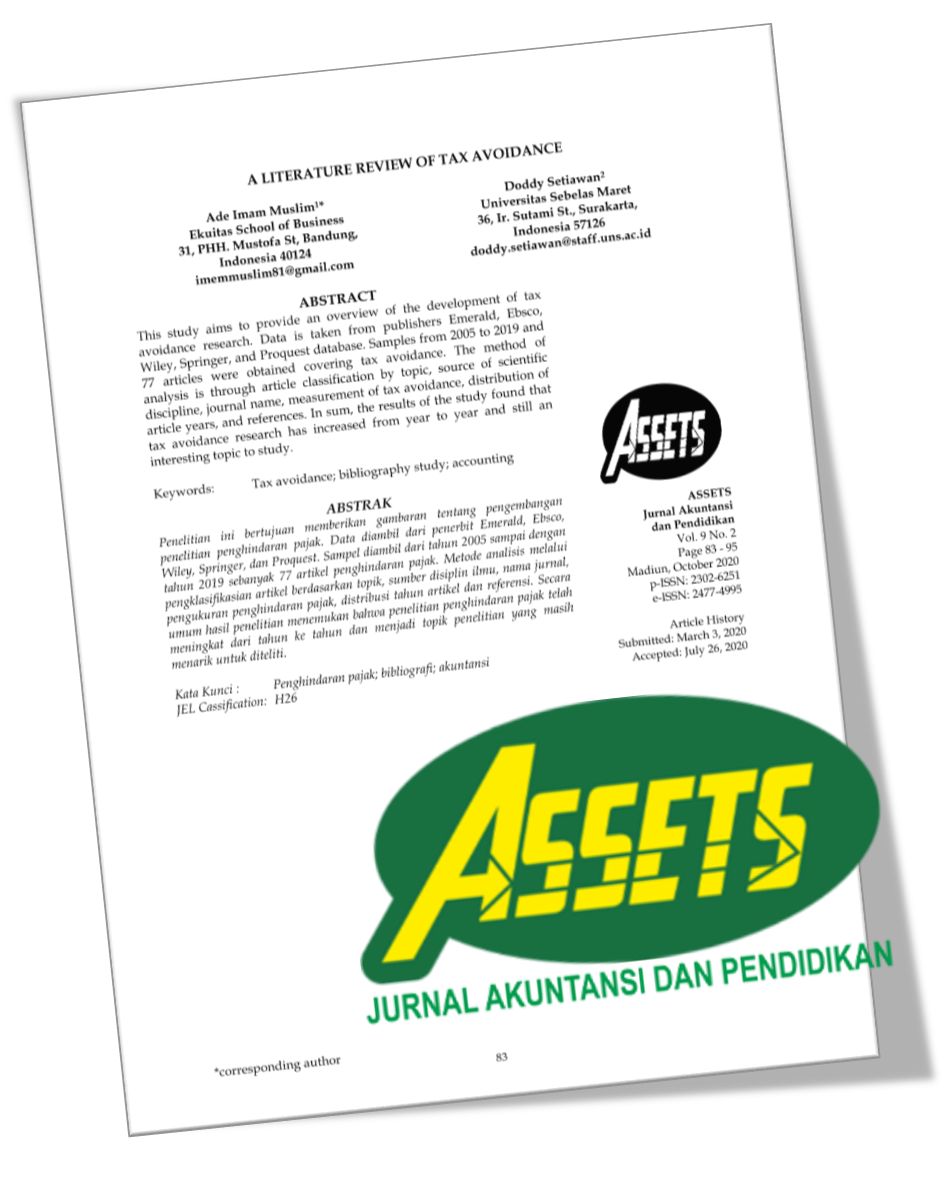Understanding Antecedents to the Satisfaction of Using Learning Management System: an Empirical Study of Accounting Students
DOI:
https://doi.org/10.25273/jap.v9i2.4927Keywords:
Perceived ease of use, Perceived enjoyment, Perceived usefulness, Satisfaction, Persepsi Kemudahan, Persepsi Kesenangan, Persepsi Kegunaan, KepuasanAbstract
ABSTRACT
This research was aimed to identify the factors affecting the Accounting students' satisfaction of using Google Classroom as one of the Learning Management System (LMS). This research analyzed the effect of perceived enjoyment, perceived ease of use, and perceived usefulness on the students' satisfaction. The sample in this research was 108 Accounting students. The data were analyzed using PLS-SEM with SmartPLS 2.0. The research results showed that the level of satisfaction of the Google Classroom was affected positively and significantly by the perceived enjoyment, perceived ease of use, and perceived usefulness. Moreover, this research also discussed the impacts of the results both theoretically and practically.
ABSTRAK
Penelitian ini bertujuan untuk mengidentifikasi faktor-faktor yang mempengaruhi kepuasan mahasiswa akuntansi dalam menggunakan google classroom yang merupakan salah satu learning management system (LMS). Penelitian ini menganalisis pengaruh perceived enjoyment, perceived ease of use, perceived usefulness terhadap kepuasan. Penelitian ini menggunakan sampel 108 responden mahasiswa akuntansi. Data dianalisis menggunakan PLS-SEM dengan software SmartPLS 2.0. Hasil penelitian menunjukkan bahwa tingkat kepuasan terhadap google classroom dipengaruhi secara positif signifikan oleh perceived enjoyment, perceived ease of use, dan perceived usefulness. Penelitian ini juga mendiskusikan dampak hasil penelitian dalam ranah teoritis dan praktis.
Downloads
References
Azian, N., Rahman, A., Hussein, N., Rusdi, S. D., & Esa, M. M. (2017). Examining the Factors that Influence Blended Learning Satisfaction Among Tertiary Students in a Public University in Malaysia. World Applied Sciences Journal, 35(4), 580–584. https://doi.org/10.5829/idosi.wasj.2017.580.584
Bandura, A. (1986). Social foundations of thought and action: A social cognitive theory. Englewood Cliffs, NJ.
Basioudis, I. G., Lange, P. de, Suwardy, T., & Wells, P. (2012). Accounting students’ perceptions of a Learning Management System: An international comparison. Accounting Research Journal, 25(2), 72–86. https://doi.org/http://dx.doi.org/10.1108/MRR-09-2015-0216
Cheng, M., & Yuen, A. H. K. (2018). Student continuance of learning management system use: A longitudinal exploration. Computers and Education, 120(June), 241–253. https://doi.org/10.1016/j.compedu.2018.02.004
Chiu, W., Cho, H., & Chi, C. G. (2020). Consumers’ continuance intention to use fitness and health apps: an integration of the expectation–confirmation model and investment model. Information Technology and People. https://doi.org/10.1108/ITP-09-2019-0463
Cho, J. (2016). The impact of post-adoption beliefs on the continued use of health apps. International Journal of Medical Informatics, 87, 75–83. https://doi.org/10.1016/j.ijmedinf.2015.12.016
Cigdem, H., & Topcu, A. (2015). Predictors of instructors’ behavioral intention to use learning management system: A Turkish vocational college example. Computer in Human Behavior, 52, 22–28. https://doi.org/10.1016/j.chb.2015.05.049
Compeau, D. R., & Higgins, C. A. (1995). Computer Self-Efficacy: Development of a Measure and Initial Test. MIS Quarterly, 19(2), 189–211.
Coşkunçay, D. F., Alkış, N., & Yıldırım, S. Ö.-. (2018). International Forum of Educational Technology & Society A Structural Equation Model for ICT Usage in Higher Education Published by : International Forum of Educational Technology & Society Linked references are available on JSTOR for this article : A Stru. Educational Technology & Society, 21(2), 13–27.
Dash, S. (2019). Google Classroom as a Learning Management System to Teach Biochemistry in a Medical School. Biochemistry and Molecular Biology Education, 1–4. https://doi.org/10.1002/bmb.21246
Davis, F. D. (1989). Perceived Usefulness, Perceived East of Use, and User Acceptance of Information Technology. MIS Quarterly, 13(3), 319–340. https://doi.org/10.1016/S0305-0483(98)00028-0
Davis, F. D., Bagozzi, R. P., & Warshaw, P. R. (1989). User acceptance of computer technology: a comparison of two theoretical models. Management Science, 35(8), 982–1003. https://doi.org/10.1287/mnsc.35.8.982
Davis, F. D., Bagozzi, R. P., & Warshaw, P. R. (1992). Extrinsic and intrinsic motivation to use computers in the workplace. Journal of Applied Social Psychology, 22(14), 1111–1132. https://doi.org/10.1111/j.1559-1816.1992.tb00945.x
Dumpit, D. Z., & Fernandez, C. J. (2017). Analysis of the use of social media in Higher Education Institutions (HEIs) using the Technology Acceptance Model. International Journal of Educational Technology in Higher Education, 14(1). https://doi.org/10.1186/s41239-017-0045-2
Hassan, H. E., & Wood, V. R. (2020). Does country culture influence consumers’ perceptions toward mobile banking? A comparison between Egypt and the United States. Telematics and Informatics, 46, 1–13. https://doi.org/10.1016/j.tele.2019.101312
Hair, J. F., Hult, G. T. M., Ringle, C. M., & Sarstedt, M. (2017). A Primer on Partial Least Squares Structural Equation Modeling ( PLS-SEM ) (Second Edition). Los Angeles: Sage Publications.
Hayashi, A., Chen, C., Ryan, T., & Wu, J. (2004). The Role of Social Presence and Moderating Role of Computer Self Efficacy in Predicting the Continuance Usage of E-Learning Systems. Journal of Information Systems Education, 15(2), 5.
Hidayat, M. W. (2018). E-Learning Makin Menarik Perhatian di 2018. Retrieved from https://www.liputan6.com/tekno/read/3226423/e-learning-makin-menarik-perhatian-di-2018
Hossain, S. F. A., Nurunnabi, M., Hussain, K., & Saha, S. K. (2019). Effects of variety-seeking intention by mobile phone usage on university students’ academic performance. Information and Communications Technology in Education, 6(1), 1–18. https://doi.org/10.1080/2331186X.2019.1574692
Hu, J., & Zhang, Y. (2016). Understanding Chinese Undergraduates ’ Continuance Intention to Use Mobile Book-Reading Apps : An Integrated Model and Empirical Study. International Journal of Libraries and Information Studies, 66(2), 1–15. https://doi.org/10.1515/libri-2015-0090
Huang, F., Teo, T., & Scherer, R. (2020). Investigating the antecedents of university students’ perceived ease of using the Internet for learning. Interactive Learning Environments, 28(1), 1–17. https://doi.org/10.1080/10494820.2019.1710540
Humbani, M., & Wiese, M. (2019). An integrated framework for the adoption and continuance intention to use mobile payment apps. International Journal of Bank Marketing, 37(2), 646–664. https://doi.org/10.1108/IJBM-03-2018-0072
Jakkaew, P. (2017). The Use of UTAUT2 Model for Understanding Student Perceptions Using Google Classroom : A Case Study of Introduction to Information Technology Course. In International Conference on Digital Arts, Media and Technology (ICDAMT). Chiang Mai, Thailand: IEEE. Retrieved from https://ieeexplore.ieee.org/document/7904962
Joo, Y. J., Park, S., & Shin, E. K. (2017). Students’ expectation, satisfaction, and continuance intention to use digital textbooks. Computers in Human Behavior, 69, 83–90. https://doi.org/10.1016/j.chb.2016.12.025
Jordan, M. M., & Duckett, N. D. (2018). Universities Confront ‘Tech Disruption’: Perceptions of Student Engagement Online Using Two Learning Management Systems. The Journal of Public and Professional Sociology, 10(1), 1–25.
Kabbiri, R., Dora, M., Kumar, V., Elepu, G., & Gellynck, X. (2018). Mobile phone adoption in agri-food sector: Are farmers in Sub-Saharan Africa connected? Technological Forecasting and Social Change, 131(December 2016), 253–261. https://doi.org/10.1016/j.techfore.2017.12.010
Kholid, M. N., Urumsah, D., & Hamdani, R. (2018). Expectation Confirmation Model in the Transportation Order Applications: Gender Differences. In 31st IBIMA Conference. Milan Italy. Retrieved from https://ibima.org/accepted-paper/expectation-confirmation-model-in-the-transportation-order-applications-gender-differences/
Kumar, J. A., & Bervell, B. (2019). Google Classroom for mobile learning in higher education : Modelling the initial perceptions of students. Education and Information Technologies, 24(2), 1793–1817.
Kumar, R. R., Israel, D., & Malik, G. (2018). Explaining customer’s continuance intention to use mobile banking apps with an integrative perspective of ECT and Self-determination theory. Pacific Asia Journal of the Association for Information Systems, 10(2), 79–112. https://doi.org/10.17705/1pais.10204
Lonn, S., & Teasley, S. D. (2009). Saving time or innovating practice: Investigating perceptions and uses of Learning Management Systems. Computers and Education, 53(3), 686–694. https://doi.org/10.1016/j.compedu.2009.04.008
Malikowski, S. R., Thompson, M. E., & Theis, J. G. (2007). A Model for Research into Course Management Systems : Bridging Technology and Learning Theory. Journal Educational Computing Research, 36(2), 149–173.
Marinkovic, V., & Kalinic, Z. (2017). Antecedents of customer satisfaction in mobile commerce of customization. Online Information Review, 41(2), 138–154. https://doi.org/10.1108/OIR-11-2015-0364
Natarajan, T., Balasubramanian, S. A., & Kasilingam, D. L. (2017). Understanding the intention to use mobile shopping applications and its in fl uence on price sensitivity. Journal of Retailing and Consumer Services, 37, 8–22. https://doi.org/10.1016/j.jretconser.2017.02.010
Pal, D., Funilkul, S., & Vanijja, V. (2018). The future of smartwatches: assessing the end-users’ continuous usage using an extended expectation-confirmation model. Universal Access in the Information Society, 19(2), 261–281. https://doi.org/10.1007/s10209-018-0639-z
Park, E. (2020). User acceptance of smart wearable devices: An expectation- confirmation model approach. Telematics and Informatics Journal, 47, 1–11. https://doi.org/10.1016/j.tele.2019.101318
Roca, J. C., Chiu, C. M., & MartÃnez, F. J. (2006). Understanding e-learning continuance intention: An extension of the Technology Acceptance Model. International Journal of Human Computer Studies, 64(8), 683–696. https://doi.org/10.1016/j.ijhcs.2006.01.003
Sezer, B., & Yilmaz, R. (2019). Learning management system acceptance scale (LMSAS): A validity and reliability study. Australasian Journal of Educational Technology, 35(3), 15–30.
Teddie, C., & Yu, F. (2007). Mixed Methods Sampling: A Typology With Examples. Journal of Mixed Methods Research, 1(1), 77–100. https://doi.org/10.1177/2345678906292430
Teo, T., Ursavaş, O. F., & Bahçekapili, E. (2012). An assessment of pre-service teachers’ technology acceptance in Turkey: A structural equation modeling approach. Asia-Pacific Education Researcher, 21 (July 2016), 191–202. 84858763296&partnerID=40&md5=ef3aac58ae408c5dcc82c482d62e6f92
Thong, J. Y. L., Hong, S. J., & Tam, K. Y. (2006). The effects of post-adoption beliefs on the expectation-confirmation model for information technology continuance. International Journal of Human Computer Studies, 64(9), 799–810. https://doi.org/10.1016/j.ijhcs.2006.05.001
Torres, R., & Gerhart, N. (2017). Mobile Proximity Usage Behaviors Based on User Characteristics. Journal of Computer Information Systems, 59(2), 1–10. https://doi.org/10.1080/08874417.2017.1320954
Vaezi, R., Mills, A., Chin, W., & Zafar, H. (2016). User Satisfaction Research in Information Systems : Historical Roots and Approaches. Communications of the Association for Information Systems, 38(27), 501–532.
Venkatesh, V., & Speier, C. (2000). Creating an effective training environment for enhancing telework. Journal Human Computer Studies, 52, 991–1005. https://doi.org/10.1006/ijhc.1999.0367
Yalcin, M. E., & Kutlu, B. (2019). Examination of students’ acceptance of and intention to use learning management systems using extended TAM. British Journal of Educational Technology, 0(0), 1–19. https://doi.org/10.1111/bjet.12798
Youn, S. yi, & Lee, K. H. (2019). Proposing value-based technology acceptance model: testing on paid mobile media service. Fashion and Textiles, 6(1). https://doi.org/10.1186/s40691-018-0163-z
Downloads
Published
Issue
Section
License
Perjanjian Lisensi dan Hak Cipta
Saat mengirimkan naskah ke jurnal, penulis menyatakan bahwa:
- Mereka diberi wewenang oleh rekan penulisnya untuk masuk ke dalam perjanjian ini.
- Karya yang dimaksud belum pernah diterbitkan secara resmi sebelumnya, kecuali dalam bentuk abstrak atau sebagai bagian dari kuliah, resensi, tesis, atau overlay jurnal yang diterbitkan.
- Karya yang dimaksud tidak sedang dipertimbangkan untuk diterbitkan di tempat lain,
- Publikasi karya yang dimaksud telah disetujui oleh semua penulis dan oleh otoritas yang bertanggung jawab - secara tahu sama tahu atau eksplisit - dari lembaga tempat pekerjaan itu dilakukan.
- Mereka mengamankan hak untuk mereproduksi materi apa pun yang telah diterbitkan atau dilindungi hak cipta di tempat lain.
- Mereka menyetujui lisensi dan perjanjian hak cipta berikut.
Hak Cipta
Penulis yang menerbitkan dengan ASSETS: Jurnal Akuntansi dan Pendidikan menyetujui persyaratan berikut:
- Penulis mempertahankan hak cipta dan memberikan jurnal hak publikasi pertama dengan karya yang secara bersamaan dilisensikan di bawah Lisensi Atribusi Creative Commons (CC BY-SA 4.0) yang memungkinkan orang lain untuk berbagi karya dengan pengakuan kepenulisan karya dan publikasi awal di jurnal ini.
- Penulis dapat masuk ke dalam pengaturan kontrak tambahan yang terpisah untuk distribusi non-eksklusif dari versi jurnal yang diterbitkan dari karya tersebut (misalnya, mempostingnya ke repositori institusional atau menerbitkannya dalam sebuah buku), dengan pengakuan publikasi awalnya di jurnal ini.
- Penulis diizinkan dan didorong untuk memposting karya mereka secara daring (misalnya di repositori institusional atau di situs web mereka) sebelum dan selama proses pengiriman, karena dapat menghasilkan pertukaran yang produktif, serta kutipan lebih awal dan lebih besar dari karya yang diterbitkan.
License and Copyright Agreement
In submitting the manuscript to the journal, the authors certify that:
- Their co-authors authorize them to enter into these arrangements.
- The work described has not been formally published before, except as an abstract or part of a published lecture, review, thesis, or overlay journal.
- That it is not under consideration for publication elsewhere,
- That its publication has been approved by all the author(s) and by the responsible authorities – tacitly or explicitly – of the institutes where the work has been carried out.
- They secure the right to reproduce any material already published or copyrighted elsewhere.
- They agree to the following license and copyright agreement.
Copyright
Authors who publish with ASSETS: Jurnal Akuntansi dan Pendidikan agree to the following terms:
- Authors retain copyright and grant the journal right of first publication with the work simultaneously licensed under a Creative Commons Attribution License (CC BY-SA 4.0) that allows others to share the work with an acknowledgment of the work's authorship and initial publication in this journal.
- Authors can enter into separate, additional contractual arrangements for the non-exclusive distribution of the journal's published version of the work (e.g., post it to an institutional repository or publish it in a book), with an acknowledgment of its initial publication in this journal.
- Authors are permitted and encouraged to post their work online (e.g., in institutional repositories or on their website) before and during submission, as it can lead to productive exchanges and earlier and more extraordinary citations of published work.

ASSETS: Jurnal Akuntansi dan Pendidikan is licensed under a Creative Commons Attribution-ShareAlike 4.0 International License.










